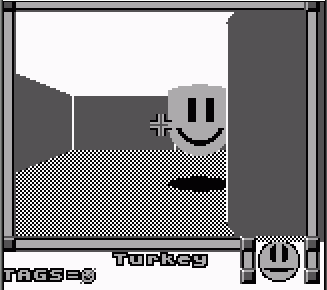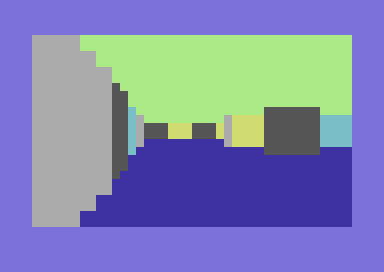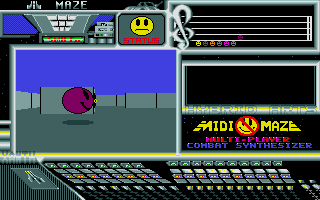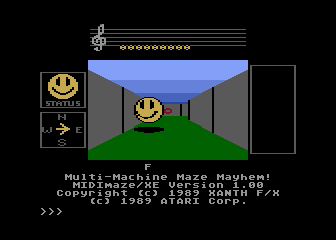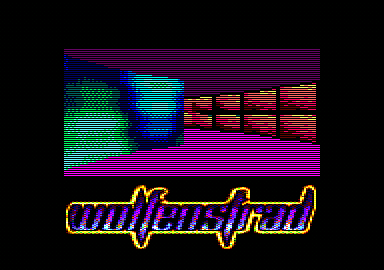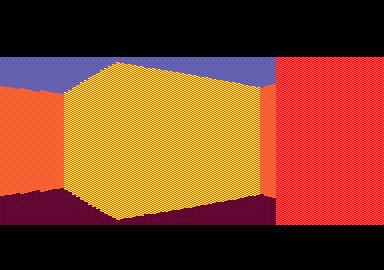DOOM/Wolfenstein for 8-bit/16-bit comps?
category: offtopic [glöplog]
Not having much to do with wolfenstein engines, but the sleeping gods picture reminds me of another dos game (shareware or freeware I think) which I'd wish to find again but don't remember anything about it. You were moving on some plains with little flat polygons, very flat with maybe few sprite trees, it was something like adventure, if you went to the water then a great cartoon animation of your hand, drowning in the water was shown, you found a castle with a walking skeleton in the hall. If someone remembers which game that was, I would be very happy to know :)
Resolution 101 on Amiga 500


Project Intercalaris on A500
_07.png)
_06.png)
_07.png)
_06.png)
Here're going 3 Doom(wolfenstein) parts from C64 demos:
Digital World/Samar - 1998
Not full-screen but nice-looking and very fast

http://www.youtube.com/watch?gl=PL&v=t57pqZJoI5k#t=3m25s
One-Der/Oxyron - 1997
This part isn't auto moving, it's controlled by joystick.

http://www.youtube.com/watch?v=TOA2LJiSU48#t=5m35s
And absolute killer: Triage 5/Smash Designs
It pays a price for it's many colours - it moves by 8 pixels, to avoid color clashes, it looks similar to Doom on Speecy.

Digital World/Samar - 1998
Not full-screen but nice-looking and very fast

http://www.youtube.com/watch?gl=PL&v=t57pqZJoI5k#t=3m25s
One-Der/Oxyron - 1997
This part isn't auto moving, it's controlled by joystick.

http://www.youtube.com/watch?v=TOA2LJiSU48#t=5m35s
And absolute killer: Triage 5/Smash Designs
It pays a price for it's many colours - it moves by 8 pixels, to avoid color clashes, it looks similar to Doom on Speecy.

I recently remembered that old thing I was talking about and discussed it in here.
Turns out that initial versions of Doom from 1.2 and before used simple mode 13h and of course 32bit blit, and only later they changed the engine to use Mode-X alike mode (it's Mode-Y really) where it was easier to blit 8bit but slower in not fast videocards. I have to downgrade my Doom version and try it. But I have heard from the same discussion that the old 13h mode remained in Heretic and Hexen. Right now, my Asus EEE pc blitting maximum 200fps in Dos (modern PC so CPU is not an issue for Doom, it's only bound by the gfx bandwidth), makes in Doom later version around 60fps but around 200fps in Heretic which was the expected. So it's true there was an issue, I should also try it again by downgrading Doom but now I am convinced.
Ok, I see that I was too crazy and maybe arrogant at that old age, so I won't bother you, I just wanted to say what I have found after years.
Turns out that initial versions of Doom from 1.2 and before used simple mode 13h and of course 32bit blit, and only later they changed the engine to use Mode-X alike mode (it's Mode-Y really) where it was easier to blit 8bit but slower in not fast videocards. I have to downgrade my Doom version and try it. But I have heard from the same discussion that the old 13h mode remained in Heretic and Hexen. Right now, my Asus EEE pc blitting maximum 200fps in Dos (modern PC so CPU is not an issue for Doom, it's only bound by the gfx bandwidth), makes in Doom later version around 60fps but around 200fps in Heretic which was the expected. So it's true there was an issue, I should also try it again by downgrading Doom but now I am convinced.
Ok, I see that I was too crazy and maybe arrogant at that old age, so I won't bother you, I just wanted to say what I have found after years.
Ooh, an oldschool raycaster thread. Since it's already bumped I'll take the opportunity and post a screenshot from an abandoned projet of mine.
I tried writing a decent raycaster for the Atari VCS. The TIA, lack of RAM (128 B) and free CPU time (~5000 cycles per frame) made it very difficult though.
There exists a homebrew wolfenstein-ish raycaster called Merlin's Walls (youtube) but it seriously compromises on the number of columns rendered. I ran out of steam attempting to make a better one though.
Here's a screenshot:
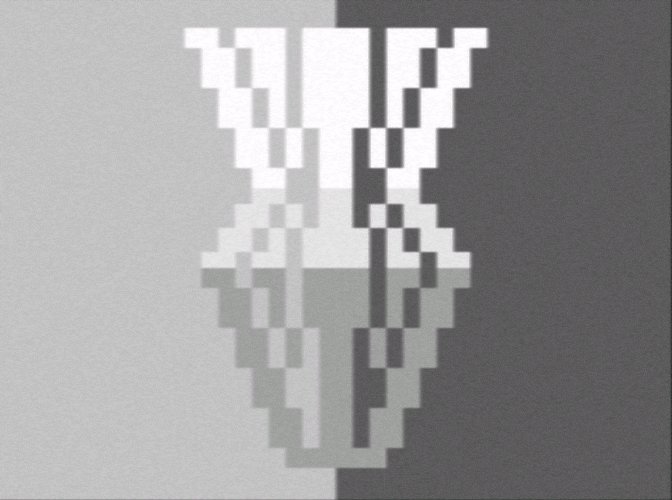
The 90 degree rotation is due to using a reflected playfield to draw the walls. Up to about twenty colored and textured wall segments could be drawn, but computing them turned out to be the difficult part.
Drawing a limited number of simple things like cubes is very much possible though - see Doctor.
I tried writing a decent raycaster for the Atari VCS. The TIA, lack of RAM (128 B) and free CPU time (~5000 cycles per frame) made it very difficult though.
There exists a homebrew wolfenstein-ish raycaster called Merlin's Walls (youtube) but it seriously compromises on the number of columns rendered. I ran out of steam attempting to make a better one though.
Here's a screenshot:

The 90 degree rotation is due to using a reflected playfield to draw the walls. Up to about twenty colored and textured wall segments could be drawn, but computing them turned out to be the difficult part.
Drawing a limited number of simple things like cubes is very much possible though - see Doctor.
Has a Maze War renderer even been implemented on the VCS? Limiting the concept to 90-degree turns would allow for a lot of major shortcuts. The diagonal lines (going to the vanishing point) could be smoothed up with sprites etc. Even though all the turns would be in 90 degrees, the depth movement could be made smooth (compare to 3Demon on MS-DOS).
viznut: Actually, there is. There's a Starpath game called "Escape from the Mindmaster" that does exactly that. It seems to make clever use of the graphics elements to draw doorways and such. It also works without rotating the TV 90 degrees :)
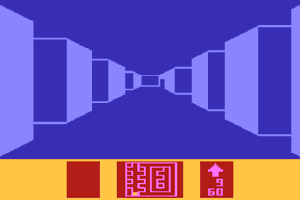



Of course that benefits from the Supercharger's additional RAM in some way.
Did anyone mention Total Eclipse (1988) for ZX Spectrum?
And Legends Of Valour (1993) which was one of the first, if not first wolf-like engine for Amiga OCS.
And Legends Of Valour (1993) which was one of the first, if not first wolf-like engine for Amiga OCS.
A totally obscure one, a Hungarian game called 'Book of Life' on the Enterprise 128. With anim gif goodness, enjoy!
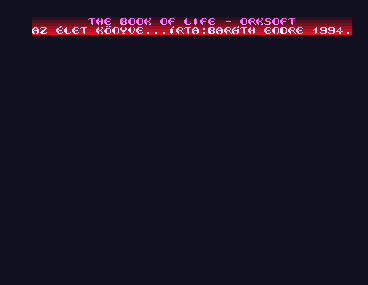

The entwerprise was a very interesting machine. combining the best things of both spectrum and CPC but with more colors and a little more flexible but custom soundchip...
Ok, and now this!
Vic20 doom
here we can also see map view
I think it's the first 8bit attempt, no matter if slow and ugly, that tries to recreate as possible as it is the original maps (and not just a wolf3d engine with doom sprites). That makes it so funny! Menus, music, map shapes/items placement like e1m1, even wipe screen effect at the end. Epic!
Vic20 doom
here we can also see map view
I think it's the first 8bit attempt, no matter if slow and ugly, that tries to recreate as possible as it is the original maps (and not just a wolf3d engine with doom sprites). That makes it so funny! Menus, music, map shapes/items placement like e1m1, even wipe screen effect at the end. Epic!
Maze3D for TI 83/84 (6/15Mhz Z80)
.

Wolfenstein3D for TI 83/84 (6/15Mhz Z80)
.

Another Doom Attempt for TI 83/84 (6/15Mhz Z80)
.
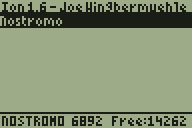
Doom89 for TI 89 (10 Mhz 68000)
.

.

Wolfenstein3D for TI 83/84 (6/15Mhz Z80)
.

Another Doom Attempt for TI 83/84 (6/15Mhz Z80)
.

Doom89 for TI 89 (10 Mhz 68000)
.

reminds me http://js1k.com/2013-spring/demo/1526
Tigrou: Reminds me of http://js1k.com/2010-first/demo/762 :p
@po1 : while you are there, where are the official results of js1k 2013?
That's a good question. I haven't seen anything from the organizer or the jury although they are all active on the Twitters :\
A port of midi maze called "Faceball 2000" for Gameboy

